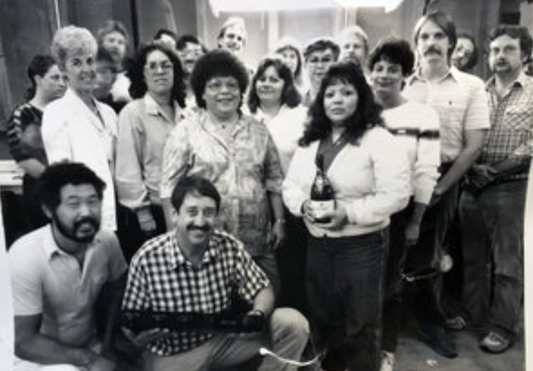Converting AC to DC, the first step necessary in building a power supply, seems rather straight forward. Take the AC and pass it through a diode (an electric one-way gate). What this does is separate the plus and minus of the AC into discrete paths: plus goes one place, negative the other. Simple. Here's what that looks like.

Notice anything about the picture? It is showing only the positive half of the AC. The diode is, as I mentioned, separating the two halves of the AC into the upper half (positive) and the lower half (negative). We are only seeing the positive half in this picture. But this process does not gives us DC. DC is what comes out of a battery and looks like a straight line. Not what you see here.
So, how do we get the voltage to look more like a straight line resembling that of a battery? We start by reducing the empty spaces between the positive 'humps' in the first picture. Notice the big space between the humps? That space is where the negative humps would appear (below the line) if we were to show them. This type of result is achieved by using only one diode for each half. It's called a half wave - for obvious reasons - because you only get one half the wave. If we add more diodes we get what's known as a full wave. It looks like this:

Note how we've managed to fill in the gaps. We are getting closer, but it still does not look like a straight line. At this point we can do no more with our little friend, the diode. We need to turn to the second major component in our power supply: a type of battery. This battery is quickly charged by the incoming power. When the power is removed the battery releases its stored energy and fills in the remaining gap. Let's take a look at what happens when we add this type of battery.

This 'battery' is called a capacitor. The capacitor is a very interesting type of battery. Essentially two plates, one conductive, the other not, it was invented way back in 1745 by Ewald Georg von Kleist. He found he could make a battery with but a few bits found around his home. This battery would store electricity and shock the living daylights out of him. Later experimenters like Pieter van Musschenbroek, inventor of the Leyden jar, and Benjamin Franklin of kite, key and lightning bolt fame, would write dire warnings to contemporaries about the potential for serious harm stored in capacitors. Lightning bolts can come from a big enough capacitor.
What's interesting is that we've only used a small handful of simple parts: 4 diodes and a couple of capacitors and we now have DC.
 Notice anything about the picture? It is showing only the positive half of the AC. The diode is, as I mentioned, separating the two halves of the AC into the upper half (positive) and the lower half (negative). We are only seeing the positive half in this picture. But this process does not gives us DC. DC is what comes out of a battery and looks like a straight line. Not what you see here.
So, how do we get the voltage to look more like a straight line resembling that of a battery? We start by reducing the empty spaces between the positive 'humps' in the first picture. Notice the big space between the humps? That space is where the negative humps would appear (below the line) if we were to show them. This type of result is achieved by using only one diode for each half. It's called a half wave - for obvious reasons - because you only get one half the wave. If we add more diodes we get what's known as a full wave. It looks like this:
Notice anything about the picture? It is showing only the positive half of the AC. The diode is, as I mentioned, separating the two halves of the AC into the upper half (positive) and the lower half (negative). We are only seeing the positive half in this picture. But this process does not gives us DC. DC is what comes out of a battery and looks like a straight line. Not what you see here.
So, how do we get the voltage to look more like a straight line resembling that of a battery? We start by reducing the empty spaces between the positive 'humps' in the first picture. Notice the big space between the humps? That space is where the negative humps would appear (below the line) if we were to show them. This type of result is achieved by using only one diode for each half. It's called a half wave - for obvious reasons - because you only get one half the wave. If we add more diodes we get what's known as a full wave. It looks like this:
 Note how we've managed to fill in the gaps. We are getting closer, but it still does not look like a straight line. At this point we can do no more with our little friend, the diode. We need to turn to the second major component in our power supply: a type of battery. This battery is quickly charged by the incoming power. When the power is removed the battery releases its stored energy and fills in the remaining gap. Let's take a look at what happens when we add this type of battery.
Note how we've managed to fill in the gaps. We are getting closer, but it still does not look like a straight line. At this point we can do no more with our little friend, the diode. We need to turn to the second major component in our power supply: a type of battery. This battery is quickly charged by the incoming power. When the power is removed the battery releases its stored energy and fills in the remaining gap. Let's take a look at what happens when we add this type of battery.
 This 'battery' is called a capacitor. The capacitor is a very interesting type of battery. Essentially two plates, one conductive, the other not, it was invented way back in 1745 by Ewald Georg von Kleist. He found he could make a battery with but a few bits found around his home. This battery would store electricity and shock the living daylights out of him. Later experimenters like Pieter van Musschenbroek, inventor of the Leyden jar, and Benjamin Franklin of kite, key and lightning bolt fame, would write dire warnings to contemporaries about the potential for serious harm stored in capacitors. Lightning bolts can come from a big enough capacitor.
What's interesting is that we've only used a small handful of simple parts: 4 diodes and a couple of capacitors and we now have DC.
This 'battery' is called a capacitor. The capacitor is a very interesting type of battery. Essentially two plates, one conductive, the other not, it was invented way back in 1745 by Ewald Georg von Kleist. He found he could make a battery with but a few bits found around his home. This battery would store electricity and shock the living daylights out of him. Later experimenters like Pieter van Musschenbroek, inventor of the Leyden jar, and Benjamin Franklin of kite, key and lightning bolt fame, would write dire warnings to contemporaries about the potential for serious harm stored in capacitors. Lightning bolts can come from a big enough capacitor.
What's interesting is that we've only used a small handful of simple parts: 4 diodes and a couple of capacitors and we now have DC.








